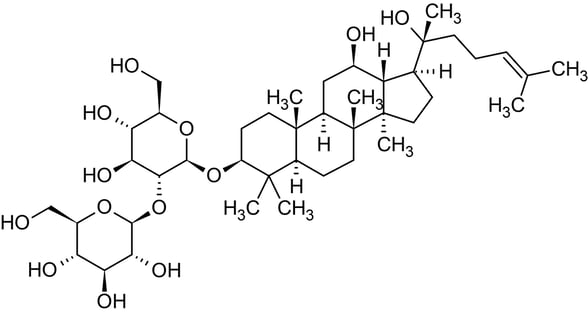
RG3-NR for NEUROINFLAMMATION

What is Neuroinflammation?
Neuroinflammation is inflammation of the central nervous system tissue. This leads to neuronal dysfunction, neuronal injury and eventually neuronal death. Causes of neuroinflammation include toxins, viruses, bacteria, stress, autoimmune conditions, traumatic brain injuries, and aging.
Chronic inflammation in the neuronal tissue is what leads to damage and neurodegenerative conditions. Common conditions include:
- Parkinson’s disease
- Alzheimer's disease & dementia
- Amyotrophic lateral sclerosis (ALS)
- Traumatic brain injury (TBI)
- Transient ischemic attack (TIA)
- Memory impairment
- Brain fog
- Chronic fatigue
- Autoimmune disease
- Learning difficulties
Critical Functions, Crucial Implications
The prevalence of neurodegenerative diseases are far reaching and can have devastating implications. Traumatic brain injury (TBI), for example, is a leading cause of injury, death and disability in the U.S.
Even without TBI, neurodegeneration affects many. As we age, memory impairment is a consequence of decline in neuronal function and increase in neurodegeneration. Oxidative stress is a major factor in brain aging and memory impairment. And more than one million adults in the U.S. are diagnosed annually with a chronic brain disease or disorder, with Alzheimer’s disease being the most prevalent cause of adult-onset brain disorders.
The support of healthy neurological function is crucial, which is why scientists are considering the importance of inflammation and apoptosis in neurodegenerative conditions.
Decreasing Neuroinflammation with Synapsin
Synapsin is a term often used to describe the combination of two products, Rg3 and Nicotinamide Ribose (NR). (credit: J. LaValle)
Rg3 is one of several triterpene saponins (ginsenosides) extracted from the root of ginseng. Laboratory studies show that Rg3 extracted from Panax ginseng supports nerve cells, helps support healthy microglial activity, healthy neuronal function and decreases microglia activation and neuroinflammatory processes. Rg3 is Neuroprotective and decreases oxidative stress of neurological tissue.
Nicotinamide riboside (NR) is a form of vitamin B3. NR supports healthy synthesis of NAD+ in human cells. Studies demonstrate the supportive and neuroprotective effect of NAD+. NR is Neuroprotective, it helps increase neuronal NAD+ production and decrease neuronal degeneration.

Benefits of Synapsin
There are powerful benefits that come from the use of synapsin to reduce neuroinflammation and support cognitive function. Here's an overview of some of the key ways synapsin helps patients.
- Neuroprotection / Cognitive support
- May improve Traumatic Brain Injury (TBI) neuroinflammation recovery
- Can aid in memory improvement
- Helps improve brain fog
- Stroke / TIA recovery
- Support for cognitive decline and related conditions (Dementia, Alzheimer’s Disease, ALS)
- Helps improve NAD+ production in the central and peripheral nervous system and regulate sirtuin expression
- Improves mitochondrial function
- Decreases microglial activation and subsequent oxidative stress and neuronal inflammation
- Improves methylation and decreases homocysteine formation. Elevated homocysteine levels are reported to increase cognitive decline including those with Alzheimer’s Disease and vascular dementia
Synapsin Dosage
Synapsin comes as a nasal spray and is administered daily. It is commonly mixed with vitamin B12 (methylcobalamin) to aid in healthy homocysteine levels and improved methylation processes.
Conclusion
Synapsin can be a powerful option If you struggle with memory issues, concentration or focus; or have concerns about dementia or age-related neurologic disorders. It works to stimulate brain healing and repair. RG3 + NAD is one of the best options to stimulate neuroregeneration.
Contact Transformyou to learn more about our options to support your health.
Research
Bao, H. Y., Zhang, J., Yeo, S. J., Myung, C. S., Kim, H. M., Kim, J. M., Kang, J. S. (2005). Memory enhancing and neuroprotective effects of selected ginsenosides. Archives of Pharmacal Research, 28(3), 335-342.
Bogan KL, Brenner C. Nicotinic acid, nicotinamide, and nicotinamide riboside: a molecular evaluation of NAD+ precursor vitamins in human nutrition. Annu Rev Nutr. 2008;11530.
Mannaa, F., Abdel-Wahhab, M. A., Ahmed, H. H., & Park, M. H. (2006). Protective role of Panax ginseng extract standardized with ginsenoside Rg3 against acrylamide-induced neurotoxicity in rats. Journal of Applied Toxicology, 26(3), 198-206. doi:10.1002/jat.1128
Belenky, P., Bogan, K. L., & Brenner, C. (2007). NAD+ metabolism in health and disease. Trends in Biochemical Sciences, 32(1), 12-19. http://dx.doi.org/10.1016/j.tibs.2006.11.006
Yang, S. J., Choi, J. M., Kim, L., Park, S. E., Rhee, E. J., Lee, W. Y. . . . Park, C. Y. (2014). Nicotinamide improves glucose metabolism and affects the hepatic NAD-sirtuin pathway in a rodent model of obesity and type 2 diabetes. The Journal of Nutritional Biochemistry, 25(1), 66-72. http://dx.doi.org/10.1016/j.jnutbio.2013.09.004
Suave, A. A. (2008). NAD+ and vitamin B3: From metabolism to therapies. The Journal of Pharmacology and Experimental Therapeutics, 324(3), 883-893. https://doi.org/10.1124/jpet.107.120758
Chi, Y., & Suave, A. A. (2013). Nicotinamide riboside, a trace nutrient in foods, is a vitamin B3 with effects on energy metabolism and neuroprotection. Current Opinion in Clinical Nutrition and Metabolic Care, 16(6), 657-661.https://doi.org/10.1097/MCO.0b013e32836510c0
Hernandez-Ontiveros, D. G., Tajiri, N., Acosta, S., Giunta, B., Tan, J., & Borlongan, C. V. (2013, March 26). Microglia activation as a biomarker for traumatic brain injury. Frontiers in Neurology, 4. https://doi.org/10.3389/fneur.2013.00030
Bieganowski, P., & Brenner, C. (2004). Discoveries of nicotinamide riboside as a nutrient and conserved NRK genes establish a Preiss-Handler independent route to NAD+ in fungi and humans. Cell, 117(4), 495-502. Retrieved from
Joo, S. S., Yoo, Y. M., Ahn, B. W., Nam, S. Y., Kim, Y. B., Hwang, K. W., & Lee, D. I. (2008). Prevention of inflammation-mediated neurotoxicity by Rg3 and its role in microglial activation. Biological and Pharmaceutical Bulletin, 31(7), 1392-1396. http://doi.org/10.1248/bpb.31.1392
Kim MJ, Koo YD, Kim M, Lim S, Park YJ, Chung SS, Jang HC, Park KS. Rg3 Improves Mitochondrial Function and the Expression of Key Genes Involved in Mitochondrial Biogenesis in C2C12 Myotubes. Diabetes Metab J. 2016 Oct;40(5):406-413. doi: 10.4093/dmj.2016.40.5.406. Epub 2016 Aug 12. PMID: 27535645; PMCID: PMC5069397.